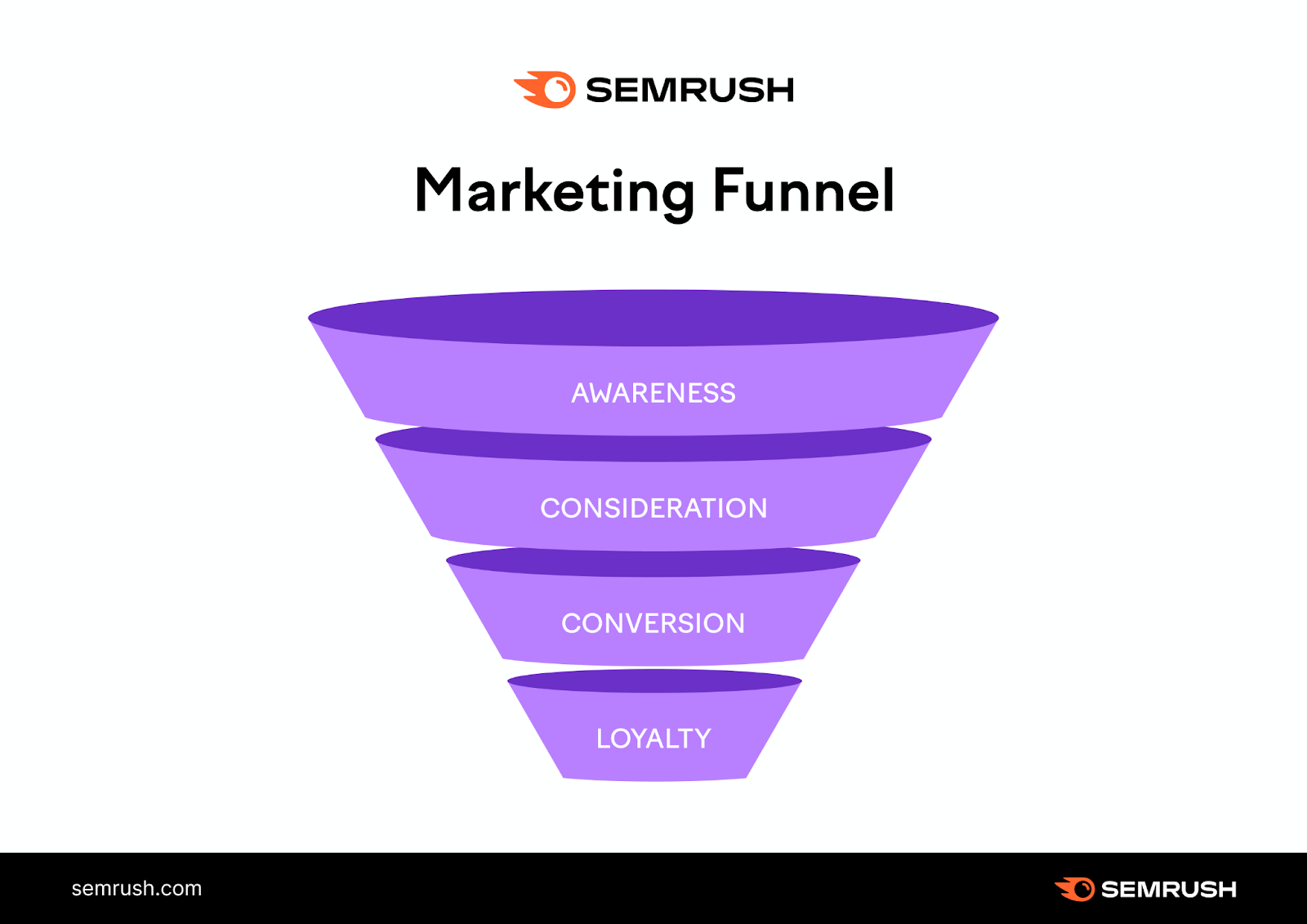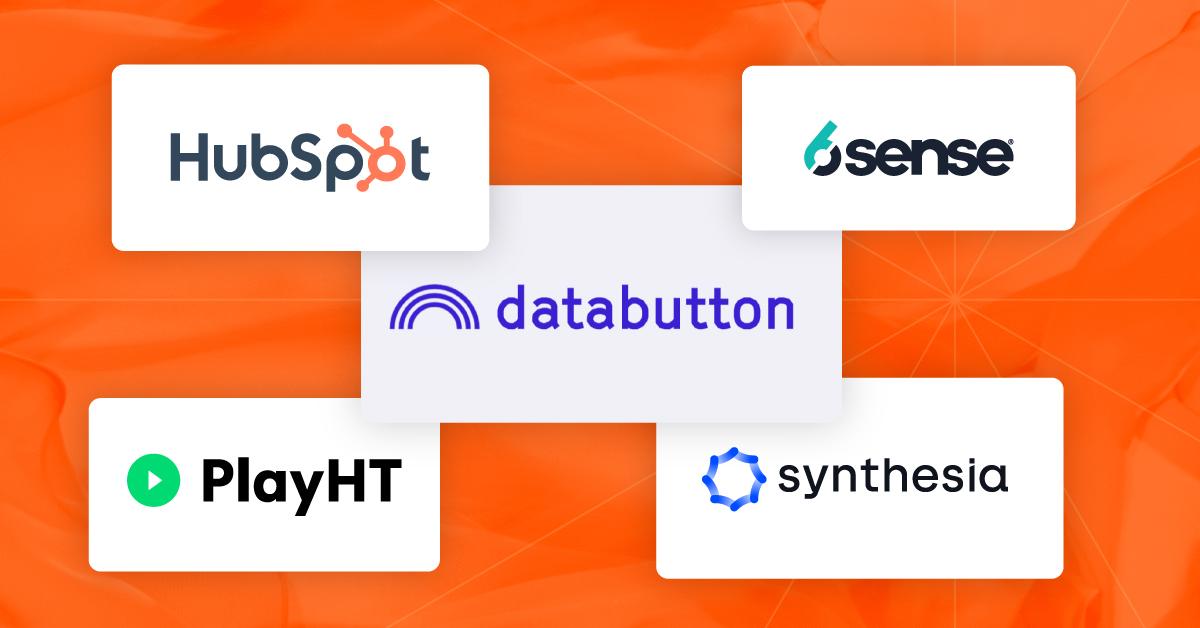The B2B marketing funnel is still a thing, but it’s no longer the same.
Picture this: you cast a wide net, hoping to capture as many leads as possible, then slowly nurture them down a linear path until they finally convert.

The 4 stages of a marketing funnel. Image credit: Semrush
The reality is that the customer journey has evolved. It’s no longer a straight line but a complex, winding path with numerous touchpoints and interactions. Potential buyers actively engage with content on their own terms, across various platforms, and at different stages of their decision-making process. They’re armed with information, and if you’re in the technology industry, many choices. As a CMO, an industry leader, driving loyalty, and measuring/reporting on marketing in insightful ways, the idea to ditch this archaic idea of pushing customers down the funnel and instead focus on ABM strategies, might have already occurred to you. In this case, your intuition is correct.
Factors driving the evolution of the funnel
The marketing landscape has changed thanks to development in technologies like AI, changes in consumer behaviour and increased buyer power. Let’s take a more detailed look.
Digital transformation and increased buyer control
The rise of digital technologies has fundamentally reshaped consumer behaviour and B2B buyer journey. Modern buyers are in the driver’s seat. With access to vast amounts of information, they self-educate through online resources (e.g. social media), peer recommendations, and various touchpoints before making decisions.

In fact, 77% of B2B purchasers don’t even speak to a salesperson until they do their own research.
This autonomy and shift in buyer behaviour disrupts the predictable path the traditional marketing funnel assumes. Users may enter and exit the funnel at different stages, sidestepping any marketing strategies we’ve laid out. A modern marketing funnel model needs to reflect this dynamic nature and create room for a flexible and responsive approach.
Emphasis on customer experience
As more customers turn to digital platforms, there is this increasing emphasis on delivering exceptional customer experiences through a more nuanced, consumer-centric marketing approach. Brands must engage customers in meaningful ways, building trust and loyalty over time. This approach requires moving beyond the funnel to a more integrated, holistic model.
And thanks to AI, we can personalise customer experience to an unprecedented degree. By analysing user behaviour and preferences using AI, we can deliver content that meets needs of each user. Hence, AI for personalisation is trending this year – so you should hop on it!
The future of marketing funnel
As the marketing landscape changes, the funnel has continued to evolve. Here are some funnel strategies you should adopt if you want to get ahead of competitors this year:
Create a superfan cycle
Customer loyalty is no longer enough. You need brand superfans.
10% of your customer base are superfans – these are people who have access and vested interest in a brand’s success. They are the most engaged, loyal and high-value customers, and they have an outsized positive influence on your bottom line.
You should focus marketing strategies on your most loyal customers. Use data and analytics to understand their specific needs, preferences and behaviours. Here’s how to tailor messaging and strategy to resonate with these superfans:
- Split the marketing funnel vertically by target audience segments and focus on the superfans within each of these segments.
- Develop personalised, high-value experiences tailored to meet the needs and preferences of this audience.
- Gather data insights and feedback from every touchpoint; they should inform your marketing strategy and drive continuous optimisation. This is where AI is your best friend.
Focus on awareness, engagement and sales
The 95:5 rule states that 95% of business buyers are not ‘in the market’ to buy. So why do we continue to push people down a funnel? Instead, we should be focusing on building brand-relevant memories.
We can measure brand with awareness (category reach and unique impressions) and engagement (clicks, downloads etc.). The more awareness and engagement your brand has, the more likely people will think of your brand at consideration. The stronger the branding and brand power, the more likely you are to be considered for your category.
Secondly, when it comes to conversion, we should be reporting on sales instead, measured with qualified hand raisers (that go on to purchase) and meetings with salespeople. In this post-cookie landscape, impressions can’t be attributable across the conversion funnel. So, these marketers need to start adopting these metrics for sales for more accurate measurement and reporting of marketing than the traditional marketing funnel.
Enhanced personalisation
As mentioned in our previous blog, enhanced personalisation is a key trend in B2B content marketing for 2024. It continues to be a driving force in the evolution of the marketing funnel. With the help of AI and machine learning, marketers can deliver hyper-personalised content and experiences that cater to individual preferences. This level of personalisation enhances customer engagement and drives conversions.
Additionally, the end of third-party cookies means going back to basics with our marketing strategies – first-party cookies. Consistently providing authentic, unique and valuable content to your customers is likely to increase brand awareness, as well as convert loyal customers to become superfans. It’s also likely to increase consumer trust, which means consumers are more likely to trust sharing their data with you – this means more insights on consumer behaviour for enhanced personalised experiences.
All about ABM
To engage buyers at every stage of the marketing funnel, or even every touchpoint, B2B marketers need to master the art of ABM. Unlike the traditional marketing funnel, ABM focuses on specific accounts, allowing for more targeted messaging, personalised content and tailored outreach. Moreover, aligning sales and marketing activities around specific target accounts brings the marketing funnel closer to the sales team, creating an effective buying experience that flows seamlessly through each stage of the funnel.
Navigate Compass, our AI platform for enterprise marketing teams to help execute your ABM campaigns at scale.
Reshape your strategies
The marketing funnel is evolving to keep pace with the ever-changing customer landscape. By embracing a more dynamic, customer-centric, and technology-driven approach, marketers can continue to guide potential customers through the buying journey effectively. The key lies in staying agile, using data and technology effectively, and delivering exceptional, personalised, customer experiences at every touchpoint.
As we look to the future, the evolved marketing funnel will undoubtedly remain a vital tool in the marketer’s arsenal. In fact, this interactive marketing funnel offers creative ways to convert your buyers at each stage of the funnel.
Why not take a trip down the marketing funnel right now?
Are you missing ABM from your marketing?
You need a strong ABM strategy in place to engage buyers at each touchpoint, at every stage of the marketing funnel. It's more than just a set of targeted content—it's understanding their journey, addressing their pain points, and planning each step of their engagement.
This requires expertise across all marketing areas. That's where we come in.


